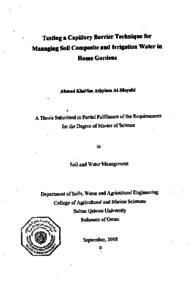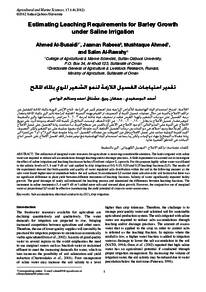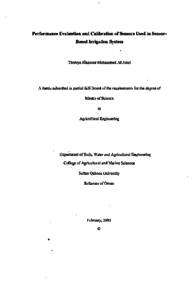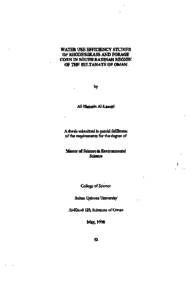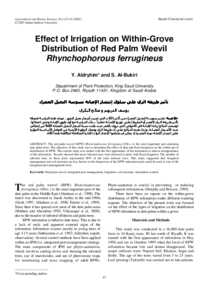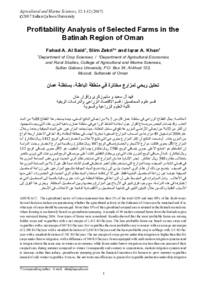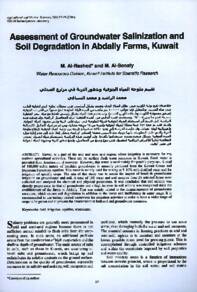Document
Testing a capillart barrier technique for managing soil composite and irrigation water in home gardens
Publisher
Sultan Qaboos University
Gregorian
2018
Language
English
Subject
English abstract
Finding new irrigating technologies that conserve water and prevent high evaporation rates is vital for home gardening in arid countries like Oman. Knowing the attitudinal and socio-demographic variables of the gardeners is necessary prior designing and applying such technologies. Objectives of this study were to: (i) identify home gardening characteristics, practices and evaluating gardener's perceptions about soil and water management, (ii) design and assess the effectiveness of Smart Capillary Barrier-Wick Irrigation system (SCB-W), a composite consisting of silt loam blocks surrounded by sand proppant, to conserve water, and (iii) model moisture dynamics, evaporation, and root water uptake (RWU) of the SCB-W system numerically using HYDRUS-3D. A sociological study using a questionnaire was conducted in 125 houses in A'Seeb area, Muscat Governorate, Oman. A pot experiment was carried out at the Agricultural Experimental Station, Sultan Qaboos University, Oman, to study the ability of SCB-W in conserving water compared to wick irrigation with homogenous soil (HW). The effect of the diameter of the wick cylinder and placing a mulched sandy layer on top of the soil composites were also investigated. HYDRUS3D was used to numerically simulate the effect of type of soil composite, i.e. SCB-W vs. HW, diameter of the wick cylinder on water dynamic and water conservation; and RWU of tomato and lettuce grown. Our study indicated that many home gardens owners are practising poor irrigation water managements, having a vague perception about crop water requirement, do not use any water-saving technologies, and hiring low-paid and not-qualified gardeners. Many gardeners highlighted the need for new technologies that save water and reduce their water bills. Based on the field experiments and numerical modelling, SCB-W stored 20% to 46% more soil water than HW. Application of SCB-W to A'Seeb area may save up to 2.6 million my of water annually that is equivalent to 1.3 million OMR. Modelling of RWU showed that plants grown in SCB-W experience less stress to water shortage. Depending on the type of plant, irrigation frequency in SCB-W can be reduced as compared with HW. Future work will include raising awareness among the gardeners and homeowners about the proper soil and water management, testing water use efficiency of the SCB-W system under field crop conditions, and improving the SCB-W design and evaluating its feasibility for home garden applications.
Keywords: Wick irrigation system; HYDRUS-3D; Irrigation efficiency; Water scarcity; Urban gardening.
Member of
Resource URL
Arabic abstract
إن إيجاد تقنيات ري جديدة التي تحافظ على المياه، وتحد من معدلات التبخر العالية يعد أمرا مهما لزراعة الحدائق المنزلية في المناطق الجافة أو شبه الجافة مثل سلطنة عمان. كما أنه يتطلب معرفة المتغيرات السلوكية والاجتماعية والديمغرافية لممارسي الزراعة في الحدائق المنزلية قبل تصميم وتطبيق هذه التقنيات. هدفت هذه الدراسة إلى: (1) تحديد الخصائص والممارسات الزراعية في الحدائق المنزلية، وتقييم نظرة ممارسيها في إدارة التربة والمياه، (2) تصميم واختبار فعالية نظام الري الذي يحتوي على الحاجز الشعري الذكي (-SCBW)، وهو عبارة عن مركب ترابي يتكون من كتل طمية محاطة بطبقة من الرمل من كل الجهات الخارجية، لحفظ المياه، (3) محاكاة ديناميكيات المياه والتبخر واستجابة النباتات للإجهاد المائي لنظام SCB-W بإستخدام برنامج HYDRUS- 3D. تم إجراء دراسة إجتماعية من خلال توزيع استبيان ل 125 منزلا في محافظة مسقط، سلطنة عمان. وأجريت التجارب الحقلية لتقييم قدرة - W في الحفاظ على المياه مقارنة مع العينة الضابطة (HW) في محطة التجارب الزراعية بجامعة السلطان قابوس، سلطنة عمان. كما تم أيضا دراسة تأثير قطر الأنبوب الحامل للماء على توزيع المياه في SCB - W و HW. وتم دراسة تأثير وضع طبقة رملية سمكها 2سم في الجزء العلوي من مركب التربة التجريبي في حفظ المياه. وكذالك تم استخدام برنامج -HYDRUS 3D لمحاكاة تأثير نوع مركبي التربة (HW SCB - W )، وقطر إسطوانة الأنبوب الناقل على مدى حفظ وديناميكية المياه واستجابة نباتي الطماطم والخس للإجهاد المائي. أشارت نتائج الدراسة الإجتماعية إلى أن العديد من ممارسي الزراعة في الحدائق المنزلية يسيئون إدارة عمليات الري؛ بسبب قلة وعيهم ومعرفتهم حول متطلبات الإحتياج المائي للنباتات، وعدم استخدامهم تقنيات توفير المياه، وأيضا تاجير عامل غير مؤهل ليقوم بزي المزروعات مقابل أجرة منخفضة. كما أشار العديد من أصحاب الحدائق رغبتهم لتقنيات جديدة تحافظ على المياه وتقلل من فواتيرها. واستنادا إلى التجارب الحقلية والنمذجة العددية، فقد وجد أن SCBsCB-W لديه القدرة على تخزين 20%-46% من المياه مقارنة ب HW. إن تطبيق نظام SCB-W في الحدائق المنزلية المنطقة السيب، يمكن أن يوفر 2 . 6 مليون متر مكعب من المياه سنوية أي ما يعادل 1.3 مليون ريال عماني. وأشارت نتائج الدراسة العددية أن الزراعة في SCB -W تقلل من الإجهاد الماني للنباتات ويمكن تقليل عدد مرات الري محسب نوع النبات- في SCB - W مقارنة ب- HW. سيتضمن العمل المستقبلي زيادة الوعي السكاني الإدارة التربة والمياه في الحدائق المنزلية، وتقييم كفاءة SCB- W في الحفاظ على المياه ونمو النباتات المختلفة من خلال التجارب الحقلية، والتحسين من تصميم SCB - W وتقييم جدوى التطبيق العملي في الحدائق المنزلية. كلمات مفتاحية: نظام الري بالخاصية الشعرية، برنامج HYDRUS-3D ، كفاءة الري، ندرة المياه، البستنة الحضرية.
Category
Theses and Dissertations

